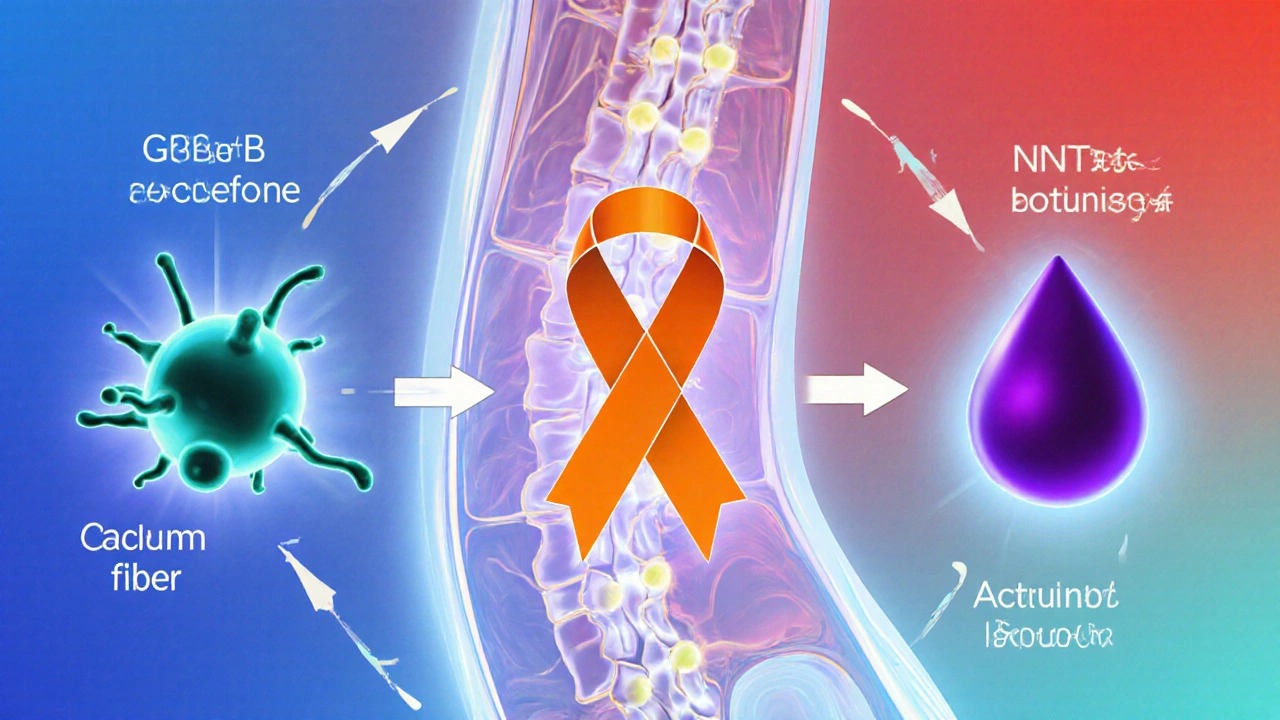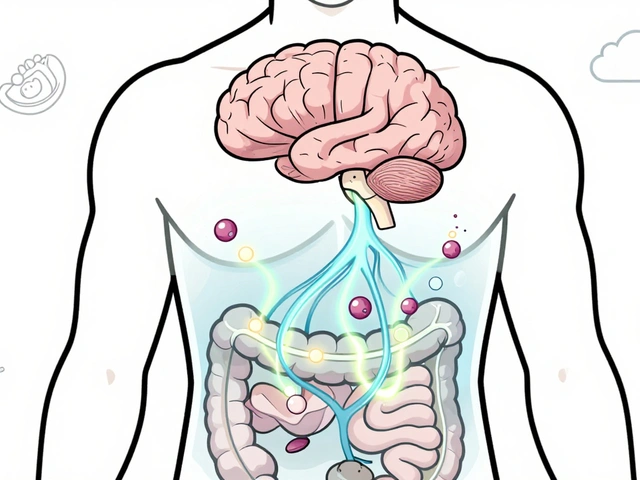Baclosign vs Alternatives: Treatment Decision Helper
Enter your conditions and click "Compare Treatment Options" to see personalized recommendations.
When doctors treat muscle spasticity, baclosign is a prescription medication that delivers the active ingredient baclofen to relax stiff muscles. It’s often recommended after stroke, multiple sclerosis, or spinal cord injury, but a growing list of alternatives can be a better fit depending on your health profile, lifestyle, and side‑effect tolerance.
What is Baclosign (Baclofen) and How Does It Work?
Baclosign (baclofen) belongs to the class of GABA‑B agonists. By binding to GABA‑B receptors in the spinal cord, it reduces the release of excitatory neurotransmitters, which in turn dampens the over‑active motor signals that cause muscle tightness. The typical oral dose starts at 5mg three times a day and can be titrated up to 80mg daily, though many patients stay below 40mg because higher doses increase the risk of dizziness, weakness, and constipation.
Because baclofen acts centrally, it can improve both spasticity and associated pain, but its central action also means it can cross the blood‑brain barrier and cause sedation. It’s approved by the FDA for spasticity, and it’s available in oral tablets as well as an intrathecal pump form for severe cases.
Common Alternatives to Baclosign
When baclofen isn’t tolerated or when clinicians want a different mechanism, several other options come into play. Below are the most frequently prescribed alternatives, each with its own strengths and trade‑offs.
- Tizanidine - a short‑acting α‑2 adrenergic agonist that reduces spasticity by decreasing nerve‑signal transmission in the spinal cord.
- Diazepam - a benzodiazepine that works on GABA‑A receptors, providing muscle relaxation and anxiety relief.
- Dantrolene - a direct muscle‑cell relaxant that interferes with calcium release from the sarcoplasmic reticulum.
- Gabapentin - originally an anticonvulsant, it dampens nerve excitability and can lower spasticity‑related pain.
- Botulinum toxin (Botox) - injected locally to block acetylcholine release, producing targeted muscle relaxation.
- Physical therapy - non‑pharmacologic approach that uses stretching, strengthening, and functional training to manage spasticity.

Side‑Effect Profiles: What to Watch For
Every drug has a unique side‑effect fingerprint. Understanding these helps you and your clinician weigh benefits against risks.
| Medication | Common Side Effects | Serious Risks | Typical Onset |
|---|---|---|---|
| Baclosign | Drowsiness, weakness, constipation, nausea | Respiratory depression (high dose), withdrawal seizures | 30‑60min |
| Tizanidine | Dry mouth, hypotension, fatigue | Liver toxicity (requires LFT monitoring) | 15‑30min |
| Diazepam | Sleepiness, ataxia, memory issues | Dependence, respiratory depression (especially with opioids) | 15‑60min |
| Dantrolene | Weakness, diarrhea, nausea | Hepatotoxicity (requires liver monitoring) | 30‑60min |
| Gabapentin | Dizziness, peripheral edema, weight gain | Rare Stevens‑Johnson syndrome | 1‑2hrs |
| Botulinum toxin | Injection site pain, flu‑like symptoms | Rare systemic spread causing muscle weakness | 3‑7days (onset of relaxation) |
Choosing the Right Option: Decision‑Making Guide
Here’s a quick checklist to help you decide whether baclosign or another therapy fits your situation:
- Severity of spasticity: Mild to moderate cases often respond well to oral baclofen or tizanidine. Severe, focal spasticity may need intrathecal baclofen pumps or botulinum toxin injections.
- Existing liver or kidney disease: Avoid tizanidine and dantrolene if liver function is compromised. Gabapentin is safer for renal adjustments.
- Risk of sedation: If you need to stay alert (e.g., driving, shift work), prefer alternatives with lower central sedation like dantrolene or botulinum toxin.
- Potential for dependence: Benzodiazepines (diazepam) carry dependence risk; reserve for short‑term use or when anxiety accompanies spasticity.
- Cost and accessibility: Oral medications are generally cheaper than intrathecal pumps or repeated Botox injections.
Discuss these points with your neurologist or physiatrist. Many clinicians start with a low dose of baclofen, monitor response for 2‑4weeks, and then add or switch to an adjunct if side effects appear.
Practical Tips for Managing Baclosign Therapy
- Take the first dose at bedtime to gauge sedation.
- Never stop abruptly; taper down over 1‑2weeks to avoid withdrawal seizures.
- Track blood pressure and liver enzymes at baseline and every 3months if you’re on high doses.
- Stay hydrated and increase fiber to combat constipation.
- Combine medication with a regular stretching routine led by a physiotherapist for synergistic benefits.

Frequently Asked Questions
Can I use baclosign while pregnant?
Baclofen is classified as Pregnancy Category C. It should only be used if the potential benefit justifies the risk to the fetus. Talk to your obstetrician before starting.
How does intrathecal baclofen differ from oral baclosign?
Intrathecal delivery pumps the drug directly into the spinal fluid, achieving higher local concentrations with far lower systemic side effects. It’s typically reserved for severe spasticity that hasn’t responded to oral therapy.
Is tizanidine more effective than baclosign?
Effectiveness varies per individual. Some patients find the rapid onset of tizanidine helpful, while others prefer baclofen’s longer half‑life. A trial of each, under medical supervision, is the best way to compare.
What should I do if I miss a dose of baclosign?
Take the missed dose as soon as you remember, unless it’s almost time for the next dose. Never double‑dose to catch up.
Are there natural alternatives to baclosign?
While supplements like magnesium or cannabis‑derived products may reduce muscle tension for some, they lack the rigorous evidence and regulatory approval that prescription muscle relaxants have. Always discuss any supplement with your healthcare provider.
Choosing a spasticity medication is rarely a one‑size‑fits‑all decision. By comparing mechanisms, side‑effect profiles, and practical considerations, you can find a regimen that eases muscle stiffness while fitting your lifestyle. Whether you stay with baclosign or switch to tizanidine, diazepam, or a non‑drug approach, the goal remains the same: regain as much functional independence and comfort as possible.






October 4, 2025 AT 13:32
When you stare at the list of muscle‑relaxant side‑effects, it feels like a midnight duel between freedom and restraint. Baclosign offers a steady hand for many, but its central action can pull the curtains on alertness. If you need to drive or keep a night shift, the sedative whisper may become a shout. Weighing the risk of dizziness against the reward of smoother movement is a personal calculus. In the end, the choice hangs on how much control you demand over your own body.